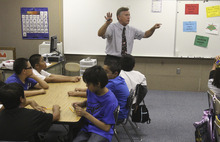This is an archived article that was published on sltrib.com in 2011, and information in the article may be outdated. It is provided only for personal research purposes and may not be reprinted.
Magna • "New math" was introduced in the U.S. and around the world more than 50 years ago. The term slowly became a punch line for adults, a tongue-in-cheek response if the answer to a mathematical question was out of reach.
Don't know the answer? "Must be that new math."
The subject received another overhaul recently, and though what is being taught to sixth-graders at Copper Hills Elementary School in Magna, and across the state, does not qualify as "new math," the manner in which it is taught is quite new.
Instead of tasking students with endless equations and drilling the answers until memorized, the new approach, called the Common Core State Standards, challenges children with reasoning.
"I'm really interested in having a true problem-based classroom," teacher Vickie Dean said. "The people who put this core together went around the world to all these places that are succeeding, like Hong Kong, Singapore and Japan, and saw problem-based classrooms.
"They saw no problem-based classroom when they came to America. In problem-based learning, the kids work in groups, they draw, they use problem-solving strategies to come up with a way they think the problem should be answered. Of course, there's more than one way to solve a problem."
Teacher Randy Haws said it's all about getting the kids to think."It's three-step thinking and four-step thinking and five-step thinking instead of one way to do things," he said. "It's a whole new way of thinking for the teachers and the students. It's a huge leap."
The first three weeks were a little rough, Haws admits, though the growing pains aren't anything new. There was a similar learning curve when the previous math core, based on the University of Chicago's Everyday Mathematics program, was implemented in 2007.
Copper Hills also has switched to the Common Core's language-arts curriculum in all grades, but the new math approach affects only the school's approximately 90 sixth-graders. The K-5 students will begin the new curriculum next year.
"Elementary-school teachers teach seven subjects a day," Copper Hills Principal Janice Flanagan said. "It's overwhelming to implement a new core for language arts at the same time you're doing a new core for math. But the math program for sixth grade was ready. The tools are there."
Dean said the school has received support from Granite School District as well as the school's parent center, which helped set up a book of course plans and resources. There also are several online resources available to assist in teaching.
"The district went through and gave us excellent curriculum maps," Dean said. "They broke the schedule down into three-week periods to make sure we cover everything. They have given us the vocabulary, the objectives … and the part that I really like are the resources."
Utah's approach to teaching math in elementary schools has for years been in line with the new Common Core's approach, Dean said. In a 2010 study by the Thomas B. Fordham Institute, Utah was in the top eight states for its math standards, with an A-minus grade.
The Common Core adopted in recent years by more than 40 states is aimed at better preparing students for the future.
"I think it's the right path," Flanagan said. "I think the Common Core is taking us to a great place for our kids. It's using all these tools and putting them together and making them work for us."
The math is the same; the difference is in the thinking and the approach.
A different approach
P Utah has begun teaching the Common Core State Standards math program to sixth-graders and will implement the program across all elementary grades next year.
It's not "new math," but the Common Core State Standards program puts the emphasis on reasoning and problem-based learning, instead of repetition and memorization.
All elementary grades switched to Common Core language arts this year. —
Making students think
I Jenny bought seven T-shirts, one for each of her seven brothers, for $9.95 each.
The cashier charged Jenny an additional $13.07 in sales tax.
If Jenny left the store with $7.28, how much money did she start with?
Answer: $90





